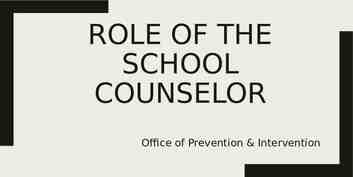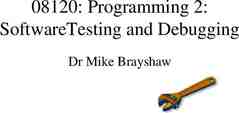Writing a Research Problem Track 1 Sunday, July 15, 2018 10:15
12 Slides91.02 KB
Writing a Research Problem Track 1 Sunday, July 15, 2018 10:15 – 11:45 a.m. Gina Peyton, Ed.D, Associate Professor David B. Ross, Ed.D, Associate Professor Nova Southeastern University Summer Institute
Brief Disclaimer We will be reviewing a brief style for your dissertation Numerous faculty philosophies Teaching styles Courses, dissertation chair, and dissertation committee member Various writing styles Only APA 6th edition format Different philosophies of hiring an editor Be careful . . . Do your homework
The Research Problem This is an area of conflict, concern, or controversy a gap between what is wanted and what is observed This is an issue or concern that an investigator presents and addresses in a research study. Must include the most relevant reference that supports the claim.
What Is a Research Problem? A research problem is an educational issue or concern that an investigator presents and justifies in a research study (Creswell, 2015), A problem is an actual situation that is hindering the overall effectiveness of an organization, The impact of the problem on the organization should be clearly stated, If the problem is too broad, the student may choose to address only certain aspects of the problem (be concise and focused), and The problem should be stated in the form of a declarative sentence.
How to know if a problem should be researched? Questions to ask yourself: Can you study the problem? Do you have access to the research site? Do you have the time, resources, and skills to carry out the research? Should you study the problem? Does it advance knowledge to the field? Does it contribute to the practice? Will your study update, fill a gap, or void in the existing literature? Will your study replicate a past study but examine different participants and research sites? Will your study extend past research or examine the topic more thoroughly?
SAMPLES . Globalization has and will influence all aspects of higher education (Flynn & Vredevoogd, 2010). The current trend of globalization has influenced the demographics in higher educational institutions. Many higher education institutions compete in a global academic marketplace, both locally and internationally. With the increase in globalization, Smith (2011) mentioned that international diversity may be substituted for domestic diversity where international issues bring a diverse perspective to a formerly American centered perspective. American colleges have partnerships with international institutions that offer study abroad opportunities and educational partnerships. Colleges serve the growing global student population at home institutions and provide global educational opportunities for local students to study abroad, connecting students to local and global communities. The increase in international students at American colleges and universities substantiates a need to understand the international student experience, which will aid colleges in better integrating international students in American colleges. In understanding the international student’s lived experiences at American colleges, educators can gain deeper cultural perspectives and incorporate culturally responsive instruction to enhance international student engagement.
SAMPLES . The service members who exit the military require specific support services as they transition from the military environment to the college campus. Higher education institutions have encountered challenges in dealing with the lack of specific support services necessary to accommodate the unique needs of students who are military veterans. Since veterans’ range in age due to the uniqueness of their armed forces affiliation, many colleges and university personnel are still at a significant disconnect with the particular types of support services needed to assist this particular student population. According to Sander (2012), less than half of institutions of higher education in public four-year colleges offer training for faculty and staff for military students and veterans' particular needs to succeed in school. Traditionally, institutions of higher learning provide support services to all students on campus. According to the U.S. Department of Education (2015), Student Support Services offices must offer academic a range of services on campus. These include tutoring; advice in course selection; assistance in completing financial aid programs and applications; aid in locating public and private scholarships; counseling services for admissions; personal, career, and academic information; exposure to mentoring programs; and help with securing temporary housing.
SAMPLES . Significant emerging trends are impacting the police chief role in the United States and influencing the KSAOs needed to perform that role. To ensure their police chiefs can effectively perform that role and lead their organizations in responding to these emerging trends, city officials must be able to apply the most job relevant criteria in selecting their police chiefs. While some studies have attempted to examine this problem, there does not exist any standardized job relevant criteria for selecting police chiefs in the United States (Johnson, 2005). Furthermore, there has been little progress in identifying fair and objective selections processes for hiring police chiefs (Cunningham, Jones, & Behrens, 2011). Additionally, police leaders and police leadership have remained largely unstudied within existing criminal justice scholarship (Schafer, 2010b). Although research studies have identified some valid job requirements for selecting police chiefs, these studies have not specifically examined how recent emerging trends are impacting the police chief role and influencing the knowledge, skills, abilities, and other characteristics needed to perform the police chief role.
SAMPLES . In 2009, President Obama pledged that the United States would exceed other countries in the number of college graduates by 2020 (Obama, 2009). In order to achieve this goal, the higher education system has to continue restructuring to allow for greater access to college, better preparation of students, and increased graduation rates (Advisory Committee on Student Financial Assistance, 2012 February; The Pell Institute, 2011; White House, 2014). In Houston, Texas, the community has recognized the need to implement programs focused on increasing the number of high school and college graduates (D. Hinojosa, personal communication, February 9, 2016). Collaborative partnerships between secondary and post-secondary education settings are instrumental to providing students with greater opportunities for learning and achieving college success. Establishing institutional partnerships allows for the sharing of resources and the alignment of high school standards and college academic expectations (Barnett et al., 2012; Burns, 2010; Conley, 2007; Lee, McAlister, Mishook, & Santner, 2013).
Professors’ contact information Department of Higher Education Leadership and Instructional Technology Dr. Gina Peyton Dr. David B. Ross Associate Professor Associate Professor [email protected] [email protected] 407-264-5633 954-262-8398 Tommy Peyton PowerPoint Developer
References: Creswell, J. W. (2015). Educational research: Planning, conducting, and evaluating quantitative and qualitative research (5th ed.). Upper Saddle River, NJ: Pearson.

















